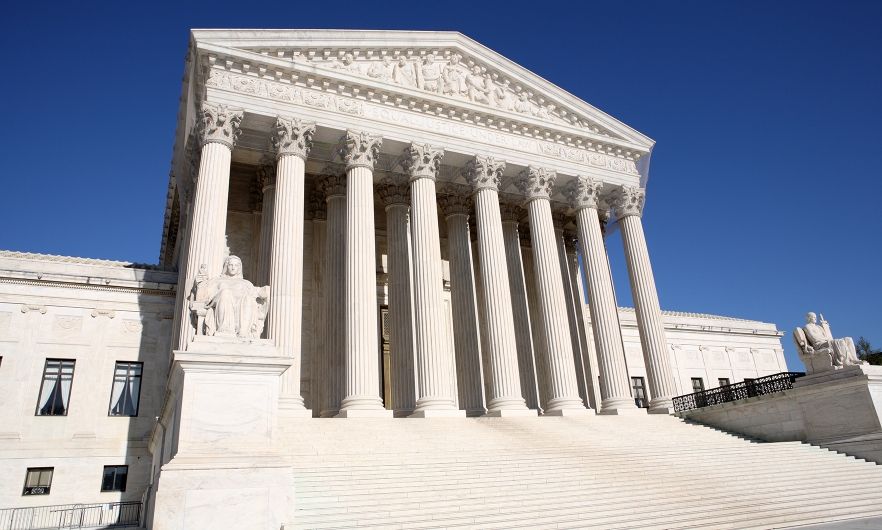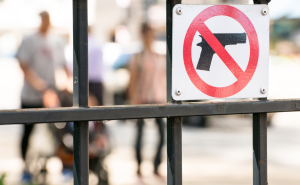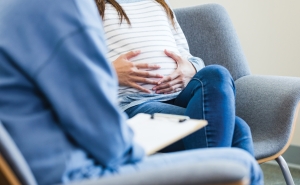The Supreme Court's Ruling on Guns
The decision on concealed carry may lead to challenges to other gun laws—and to public health.

Seven U.S. states—California, Hawaii, Maryland, Massachusetts, New Jersey, New York, and Rhode Island—have laws strictly regulating who may carry a gun in public. Yesterday, the U.S. Supreme Court ruled that New York’s law, which had been in place since 1913, is unconstitutional.
The ruling, a 6–3 ruling with conservative justices in the majority, was not unexpected, but now states with similar laws—as well as other laws that may conflict with this Court’s broader interpretation of Second Amendment rights—are racing to protect both gun rights and public safety.
In this Q&A, adapted from a bonus episode of Public Health On Call, Alex McCourt, PhD ’19, JD, MPH, director of legal research at the Johns Hopkins Center for Gun Violence Solutions, speaks to Josh Sharfstein about this decision's meaning and direct impact, as well as the potential implications for other actions to reduce the toll of gun violence in the U.S.
The June 23 Supreme Court decision on guns is one of the big cases this term that everyone's been watching. Tell us what it’s about.
This case, New York State Rifle & Pistol Association v. Bruen, is focused on New York State's concealed carry permitting law. New York has a law in place, and has for many years, that requires residents of the state to secure a permit to carry a gun in public. As part of this process, applicants have to show that they have a proper cause for wanting to carry in public, and this proper cause has to be greater than maybe a member of the general public might need. They have to show a special need for carrying a gun in public.
What happened here is that two guys applied for concealed carry permits. One said that his reasoning was that there had been a string of robberies in his neighborhood. The other said that he just wanted it for self-defense.
When they were both denied permits, they appealed with the help of the New York State Rifle & Pistol Association, and the case ultimately went all the way to the Supreme Court.
New York allows people to have guns in their homes, and they allow people to have a concealed permit if it is justified. What were some of the justifications that New York permitted?
Usually, things like a particular threat—maybe threats have been made to your life or to members of your family—were seen as a special need or a proper cause. But they couldn't be general or vague, like “there have been robberies in my neighborhood.” That's not specific enough, according to law enforcement. But it's really important to keep in mind that this state law did not define proper cause at all, so law enforcement could really use their discretion to figure out whether somebody met this requirement.
So, enter the Supreme Court. What happened today?
The Supreme Court heard this case back in the fall and just issued the opinion today. A split decision, 6–3, with the more conservative members in the majority and the more liberal members in the minority, struck down New York's law.
They said the law violates the 14th and Second Amendments. In doing so, they specifically said that the Second Amendment protects the public carry of firearms, which was not the case before today. They also set up a new test for courts to determine whether a law violates the Second Amendment.
So the short story is that New York's law is struck down, and other laws like New York's, which are present in a handful of other states, are also likely to be struck down.
That new test has to do with history. Is that right?
It does. This all started with District of Columbia v. Heller in 2008. That case was the very first time that the Supreme Court recognized an individual right to own a gun. And in that case, no test was set up, so lower courts didn't know how to determine whether a gun law violates the Second Amendment. Eventually, they worked out this two-part test: Is this something that historically implicates the Second Amendment? And if so, how does it hold up against scrutiny—is this something that the government has a good rationale for doing, that they have an interest in, and that is tailored to address that interest?
Many laws were upheld because the government has a strong interest in reducing violence, and these laws were intended to reduce violence. What this specific opinion says is, That second part is no longer part of the equation. Instead, what courts should do is look at texts, history, and tradition: We should look at American history and American tradition to determine whether a given law violates the Second Amendment.
Is that how we generally think about constitutional rights—that basically, we should look at history as the sole determinant of whether restrictions can be placed on them? As a non-lawyer, reading that struck me as a little strange.
The majority opinion certainly makes the argument that this is something that we do with other laws. But that's not necessarily the case. This standard that they got rid of—where they applied different levels of scrutiny, depending on what rights a law implicates—is very common in both state and federal court. It’s not, I think, quite correct to say that, Well, yeah, we use this approach all the time.
To me, it seems a little more ambiguous. And really the test still isn't that clear. I think a lot of people were at least hoping that no matter how the case came down, there would be a clear test to tell us, Okay, this is how courts will analyze it. But this is still unclear, because history is not necessarily simple.
There were some concurring opinions here, which pointed out that this doesn't mean that everyone gets to carry around whatever kind of gun they want, or at least that's how I read them.
Justice Kavanaugh wrote a concurring opinion. He agreed with Justice Thomas' majority opinion that this law violates the Second Amendment and should be struck down, but he pointed out that this doesn't implicate permits in general. So, states are still allowed to say you have to apply for a permit and get a permit before you can carry a gun in public. What they can't do is have this discretionary piece.
My read of this concurring opinion is that it's very similar to something Justice Scalia did in the Heller opinion in 2008, which is to say, yes, there's this right, but it's not unlimited. States and the federal government have the ability to limit it, to make sure that only responsible people or only people that have been deemed non-dangerous are carrying guns.
There’s an effort, I think, as you pointed out, to say, “This is not a free-for-all; this is something that is still not unlimited. And states can do things to regulate guns.”
Does that potentially allow banning certain types of guns?
I think there are instances where the court has generally acknowledged that certain types of guns, especially guns that had not been considered at the founding, might not be as protected or might not be protected at all by the Second Amendment. That's still a difficult argument, and that was not part of the case here. So it doesn't necessarily mean that a future opinion will come down in that way. But it is, I think, a very small silver lining here that maybe there's some room still to regulate.
Tell us about the dissents.
The dissenting opinion focused much more on public health. There were citations to all sorts of studies, both in the public health scholarship and in other social sciences, saying that we can't even have this discussion without talking about the public health impact of guns and gun violence, that that's a key piece of this, and that the majority opinion just disregarded it.
Justice Alito, in his concurring opinion, was very dismissive of public health evidence. He said, basically, “Well, if New York's law is so great, why did the Buffalo shooting happen?” In the concurring opinions, there was a lot of disregard for public health evidence. But the dissent was very focused on public health evidence, saying, “Look, we know there are laws that can reduce gun violence. And that has to be part of a court's consideration. We have to be considering this when we're evaluating these laws.”
It used to be that people who were being considered for the Supreme Court said that they should be restrained in striking down state laws that were passed democratically in order to accomplish important goals. But this seems like an aggressive way of striking down democratically passed laws.
It does seem that way, and Justice Thomas in the majority opinion even alludes to that. He says, “Yes, there are times that the court should defer to legislatures, but when we're talking about an individual right as important as the Second Amendment, we can't do that. We have to look to history and tradition and not defer to the legislature.” But it's not clear to me why he makes that determination.
You are a lawyer as well as a public health expert. How do you put all this together? What do you think is going to happen as a result of this opinion?
I think the big takeaways are actually more public health–oriented. We know that laws like New York's that require proper cause are not going to exist anymore. And there are, I think, public health reasons for not really liking those laws. For example, do we think that this discretion afforded law enforcement agencies is good or bad from a public health perspective? There really hasn’t been research on that.
Those are known as “may issue laws,” and they're pretty restrictive. It can be hard to get a concealed carry permit. In other states that have what we call “shall issue laws,” or even laws that allow you to carry without a permit, we see increases in gun violence. So it's likely that we'll see increases in gun violence in some of the states that have to get rid of these discretionary laws.
But I think the bigger public health impacts are from this expanded Second Amendment to cover outside the home and the new test for the Second Amendment. We’re going to see many, many more challenges to gun laws, including gun laws that have a really strong evidence base, like permit-to-purchase laws, extreme risk protection order laws, safe storage laws, and minimum age laws. It would not be surprising at all to see a huge wave of litigation related to these to see if, under this new test, courts are more willing to strike down these laws. And a big question is how courts will apply this text, history, and tradition test to other gun laws.
Joshua Sharfstein, MD, is the vice dean for Public Health Practice and Community Engagement and a professor in Health Policy and Management at the Johns Hopkins Bloomberg School of Public Health. He is also the director of the Bloomberg American Health Initiative and a host of the Public Health On Call podcast.




